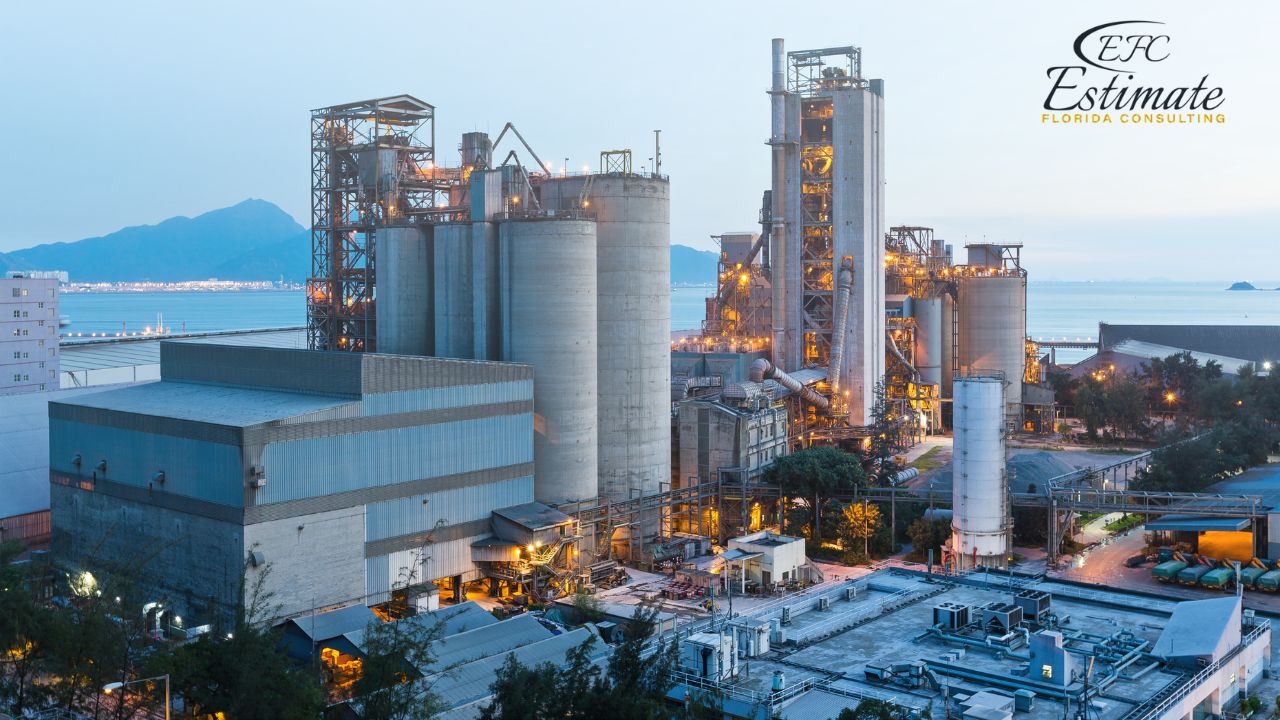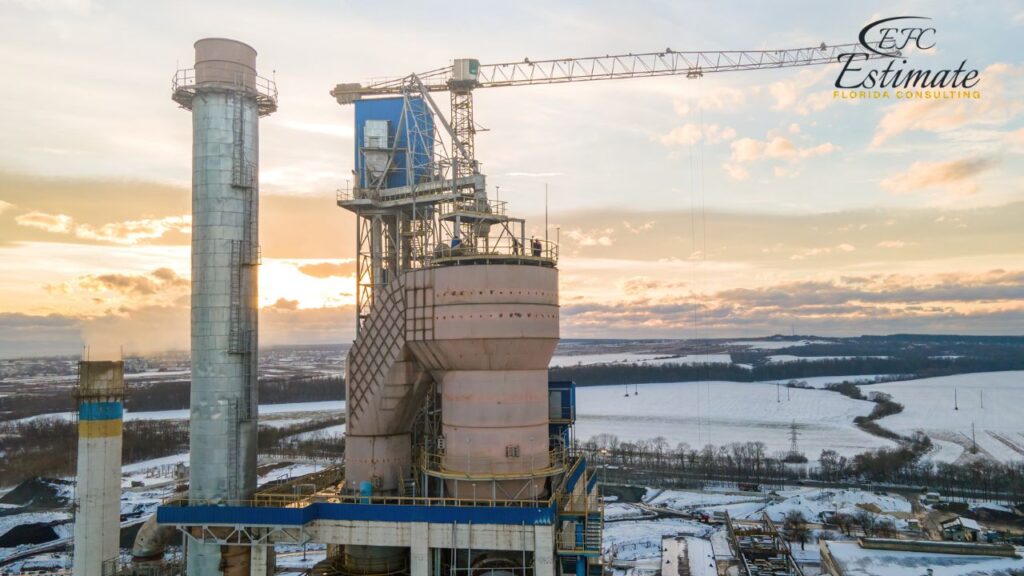Take the First Step For Estimate!
- Accurancy
- Efficiency
- Transparency
- Customization
- Time Saving
- Professionalism
- Cost Control

The Manufacturing Plant Construction Cost Estimator is a crucial tool in accurately predicting expenses for building facilities, with costs significantly influenced by factors such as location, size, and technological requirements. For small-scale plants, expenses might start around $250,000, while large, technologically advanced facilities can see costs soaring beyond $100 million. This comprehensive guide aims to illuminate the complexities of construction cost estimation, emphasizing the vital importance of precision in forecasting. Accurate estimations are indispensable, serving as the financial compass for project management and decision-making.

By dissecting the elements that drive construction costs, from material prices to labor rates, this article offers a deep dive into the economic intricacies of establishing a manufacturing plant, guiding stakeholders through the fiscal challenges to achieve project feasibility and success within an allocated budget of typically $10 million to $30 million for mid-sized projects.

Manufacturing Plant Size | Estimated Construction Costs |
Small-scale | Starting at approximately $250,000 |
Mid-sized | $10 million to $30 million |
Large-scale, Advanced | Exceeding $100 million |
Construction Aspect | Estimated Cost Influence |
Location & Site Preparation | $50,000 to $500,000+ |
Size & Complexity | Small-scale: ~$250,000 to $2M |
Mid-sized: $10M to $30M | |
Large-scale, Advanced: $100M+ | |
Technological Requirements | 5% to 25% increase over base costs |
Labor Rates | 20% to 40% of total construction cost |
Material Costs | 30% to 50% of total construction cost |
Regulatory Compliance | $10,000 to $100,000+ |
At the core of construction expenses lie material costs. Fluctuations in the prices of raw materials can significantly impact the overall budget of a manufacturing plant project. Exploring reliable suppliers and negotiating favorable contracts become pivotal strategies in cost management. Additionally, considering alternative materials and assessing their long-term durability contributes to both cost-effectiveness and sustainability.
The workforce is a substantial component of construction costs. Skilled labor shortages, wage fluctuations, and the need for specialized expertise can pose challenges. Addressing these issues through effective workforce planning and training initiatives is essential for budgetary success. Moreover, implementing innovative construction methodologies, such as modular construction, can optimize labor resources and mitigate costs.

The utilization of construction equipment comes at a price. From cranes to excavators, understanding and accounting for equipment costs is crucial for accurate estimation. Choosing the right equipment and optimizing its usage contribute to overall cost efficiency. Moreover, exploring the option of renting equipment instead of outright purchase can offer financial flexibility and reduce upfront capital expenses.
Meeting regulatory requirements is non-negotiable in construction projects. Failing to factor in compliance costs can lead to unforeseen expenses. Staying informed about local regulations and ensuring adherence from the outset is key to cost-effective construction. Collaborating with regulatory authorities early in the planning phase can streamline the approval process and prevent costly delays.

ZIP Code Based Estimate
Highly Accurate

Fully Insured Licensed Hire Sub-Contractor For Manufacturing Plant Construction
Hire Contractor
Make Informed Design Decisions Showcase Your Design Ideas
Get RenderingThoroughly analyzing and preparing the construction site is foundational. Site conditions, accessibility, and potential challenges must be identified and addressed early in the planning phase. Conducting geotechnical studies and environmental impact assessments contribute to a comprehensive understanding of site-related factors that can influence costs.
The design and engineering phase involves translating project requirements into tangible plans. Collaborating with architects and engineers ensures that the design aligns with cost constraints while meeting functional objectives. Integrating sustainable design principles at this stage can lead to long-term cost savings and environmental benefits.
Strategic procurement of materials involves sourcing quality supplies at competitive prices. Building relationships with suppliers and monitoring market trends can aid in securing cost-effective materials. Additionally, exploring recycled or locally sourced materials aligns with sustainability goals and can offer cost advantages.
The construction phase entails bringing the project to life. Efficient project management, skilled labor deployment, and adherence to timelines are critical for staying within budgetary constraints. Implementing lean construction practices, which focus on minimizing waste and optimizing efficiency, contributes to cost-effectiveness.

Unforeseen challenges are inevitable. Allocating a contingency budget for unexpected costs provides a safety net, reducing the impact of surprises on the overall project budget. The contingency plan should be dynamic, with regular reviews and adjustments based on evolving project conditions.
BIM is a game-changer in construction planning. It allows for the creation of detailed 3D models, facilitating better visualization and analysis of the project. This technology enhances accuracy and collaboration among stakeholders. Integrating BIM into the estimation process provides a virtual walkthrough of the project, identifying potential clashes and optimizing spatial utilization.
Artificial intelligence and machine learning bring predictive capabilities to cost estimation. These technologies analyze historical data and project complexities, providing more accurate projections and reducing the margin of error. Machine learning algorithms can continuously learn and adapt, refining cost estimates as the project progresses.
Virtual reality immerses stakeholders in a virtual representation of the construction project. This not only aids in visualizing the final product but also enhances communication, reducing misunderstandings and potential rework costs. Virtual reality simulations can be used for training construction teams, improving overall project efficiency.
The volatility of material costs presents a constant challenge. Continuous monitoring of market trends, establishing long-term contracts, and considering alternative materials are strategies to mitigate the impact. Collaborating with suppliers to secure pricing guarantees or exploring bulk purchasing agreements can provide stability in material cost projections.
A shortage of skilled labor can result in increased labor costs. Investing in training programs, fostering partnerships with vocational institutions, and adopting technology to augment labor capabilities can address this challenge. Collaborating with local trade organizations and educational institutions can contribute to the development of a skilled labor pool.

Site conditions may differ from initial assessments. Conducting thorough site analyses and factoring in potential deviations during planning contribute to more accurate estimations. Implementing advanced site survey technologies, such as LiDAR and ground-penetrating radar, enhances the identification of subsurface conditions.
Professional estimators bring a wealth of experience and expertise to the table. Their knowledge of industry trends, regulations, and historical data enhances the accuracy of cost estimates. Engaging a certified estimator with a track record in similar projects ensures a thorough understanding of the unique challenges and requirements associated with manufacturing plant construction.
Estimators are adept at identifying potential risks that could impact costs. Their proactive approach to risk mitigation contributes to a more resilient project that can withstand unforeseen challenges. Conducting comprehensive risk assessments at various stages of the project ensures that potential cost-influencing factors are addressed in the estimation process.
So, why wait? Send us your plans and give us a call now. Let’s make your project a success together!

Engaging a professional estimator not only ensures accuracy but also saves valuable time. Their efficiency in analyzing data and creating estimates allows for streamlined decision-making and project planning. The time saved can translate into cost savings, especially in fast-track construction projects where timely decisions are critical.
As sustainability becomes a focal point, future cost estimation will incorporate green building practices. Budgeting for environmentally friendly materials and technologies will be integral to construction projects. Estimators will need to stay abreast of evolving eco-friendly solutions and assess their cost implications.
The integration of robotics is transforming construction processes. Estimators will need to account for the costs and benefits associated with robotic technologies, from automated bricklaying to drone-assisted site surveys. Collaborating with robotics experts during the estimation phase ensures accurate projections of the expenses related to these technological advancements.

The use of predictive analytics will become more prevalent in cost forecasting. Analyzing data trends and project complexities will enable more accurate predictions, allowing for proactive budget adjustments. Estimators will leverage data analytics tools to refine their forecasting models, incorporating variables such as economic indicators and supply chain dynamics.
The role of a Manufacturing Plant Construction Cost Estimator is pivotal in navigating the complex landscape of construction expenses. From understanding the intricacies of material and labor costs to embracing advanced technologies, the journey involves multifaceted strategies for success. The ability to adapt to industry trends, leverage technology, and engage professionals contributes to the resilience and financial viability of manufacturing plant construction projects.
Technology plays a transformative role, enhancing accuracy through tools like BIM, AI, and virtual reality. These technologies streamline processes and improve collaboration, resulting in more precise cost estimates. Integrating emerging technologies into the estimation process ensures a competitive edge in the evolving construction landscape.
Unforeseen challenges, such as material price fluctuations or site conditions, can disrupt budgets. Contingency planning and proactive risk management are essential to mitigate the impact on cost estimates. Estimators must anticipate potential challenges and incorporate flexible budgetary provisions to navigate unforeseen circumstances.
Yes, accurate cost estimation allows for strategic budgeting for sustainable practices. Allocating resources for green building materials and technologies supports environmental goals without exceeding financial constraints. Estimators play a crucial role in assessing the cost-effectiveness of sustainable solutions and guiding stakeholders toward eco-friendly choices.
Virtual reality enhances visualization and communication in construction planning. Stakeholders can virtually experience the project, minimizing misunderstandings and reducing the likelihood of costly rework. The benefits extend beyond cost savings to improved collaboration, enhanced decision-making, and a more immersive understanding of project complexities.
Ensuring accuracy requires a combination of experienced professionals, advanced technologies, and ongoing monitoring. Regularly updating estimates based on real-time project data enhances precision and reduces the risk of budget overruns. Companies should prioritize hiring certified estimators, embracing cutting-edge technologies, and fostering a culture of continuous improvement in cost estimation practices.
Here I am going to share some steps to get a manufacturing plant construction cost estimate report.
You can send us your plan on info@estimatorflorida.com
Before starting your project, we send you a quote for your service. That quote will have detailed information about your project. Here you will get information about the size, difficulty, complexity and bid date when determining pricing.
Our team will takeoff and estimate your project. When we deliver you’ll receive a PDF and an Excel file of your estimate. We can also offer construction lead generation services for the jobs you’d like to pursue further.



561-530-2845
info@estimatorflorida.com
Address
5245 Wiles Rd Apt 3-102 St. Pete Beach, FL 33073 United States
561-530-2845
info@estimatorflorida.com
Address
5245 Wiles Rd Apt 3-102 St. Pete Beach, FL 33073 United States
All copyright © Reserved | Designed By V Marketing Media | Disclaimer